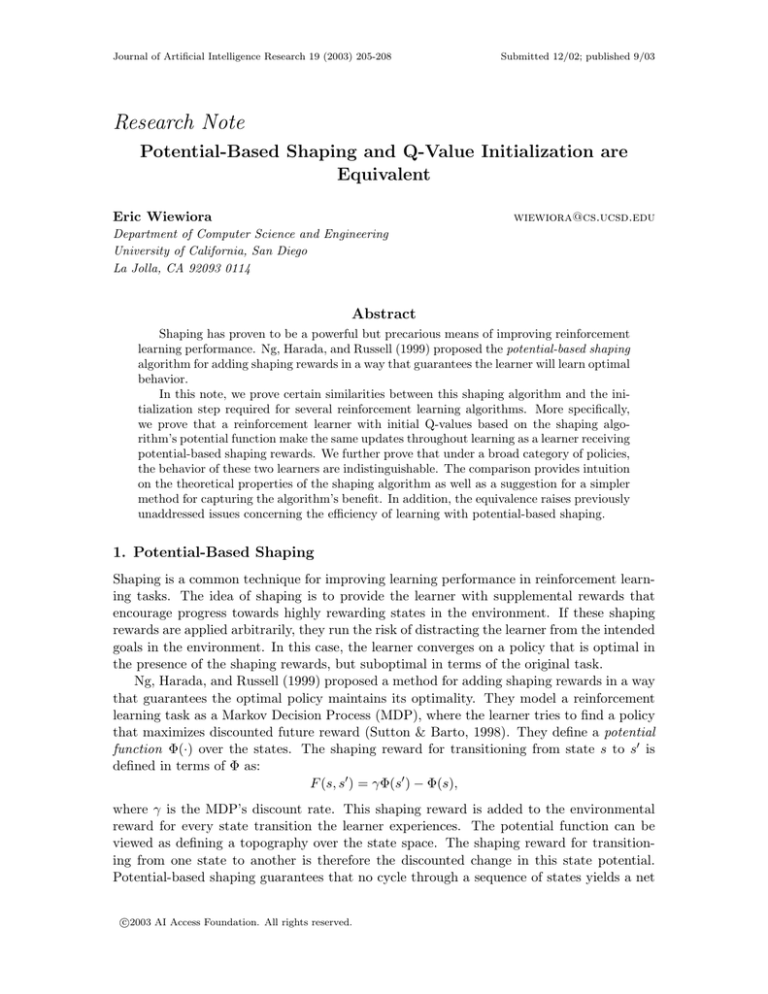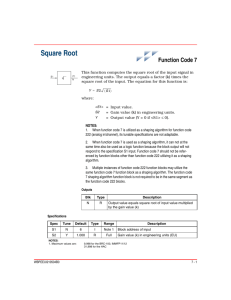
Journal of Artificial Intelligence Research 19 (2003) 205-208
Submitted 12/02; published 9/03
Research Note
Potential-Based Shaping and Q-Value Initialization are
Equivalent
Eric Wiewiora
wiewiora@cs.ucsd.edu
Department of Computer Science and Engineering
University of California, San Diego
La Jolla, CA 92093 0114
Abstract
Shaping has proven to be a powerful but precarious means of improving reinforcement
learning performance. Ng, Harada, and Russell (1999) proposed the potential-based shaping
algorithm for adding shaping rewards in a way that guarantees the learner will learn optimal
behavior.
In this note, we prove certain similarities between this shaping algorithm and the initialization step required for several reinforcement learning algorithms. More specifically,
we prove that a reinforcement learner with initial Q-values based on the shaping algorithm’s potential function make the same updates throughout learning as a learner receiving
potential-based shaping rewards. We further prove that under a broad category of policies,
the behavior of these two learners are indistinguishable. The comparison provides intuition
on the theoretical properties of the shaping algorithm as well as a suggestion for a simpler
method for capturing the algorithm’s benefit. In addition, the equivalence raises previously
unaddressed issues concerning the efficiency of learning with potential-based shaping.
1. Potential-Based Shaping
Shaping is a common technique for improving learning performance in reinforcement learning tasks. The idea of shaping is to provide the learner with supplemental rewards that
encourage progress towards highly rewarding states in the environment. If these shaping
rewards are applied arbitrarily, they run the risk of distracting the learner from the intended
goals in the environment. In this case, the learner converges on a policy that is optimal in
the presence of the shaping rewards, but suboptimal in terms of the original task.
Ng, Harada, and Russell (1999) proposed a method for adding shaping rewards in a way
that guarantees the optimal policy maintains its optimality. They model a reinforcement
learning task as a Markov Decision Process (MDP), where the learner tries to find a policy
that maximizes discounted future reward (Sutton & Barto, 1998). They define a potential
function Φ(·) over the states. The shaping reward for transitioning from state s to s0 is
defined in terms of Φ as:
F (s, s0 ) = γΦ(s0 ) − Φ(s),
where γ is the MDP’s discount rate. This shaping reward is added to the environmental
reward for every state transition the learner experiences. The potential function can be
viewed as defining a topography over the state space. The shaping reward for transitioning from one state to another is therefore the discounted change in this state potential.
Potential-based shaping guarantees that no cycle through a sequence of states yields a net
c
2003
AI Access Foundation. All rights reserved.
Wiewiora
benefit from the shaping. In fact, under standard conditions Ng et al. prove that any policy
that is optimal for an MDP augmented with a potential-based shaping reward will also be
optimal for the unaugmented MDP.
2. New Results
Many reinforcement learning algorithms learn an optimal policy by maintaining Q-values.
Q-values are estimates of the expected future reward of taking a given action in a given
state. We show that the effects of potential-based shaping can be achieved by initializing
a learner’s Q-values with the state potential function. We prove this result only for the
Q-learning algorithm, but the results extend to Sarsa and other TD algorithms as well.
We define two reinforcement learners, L and L0 , that will experience the same changes in
Q-values throughout learning. Let the initial values of L’s Q-table be Q(s, a) = Q0 (s, a). A
potential-based shaping reward F based on the potential function Φ will be applied during
learning. The other learner, L0 , will have a Q-table initialized to Q00 (s, a) = Q0 (s, a) + Φ(s).
This learner will not receive shaping rewards.
Let an experience be a 4-tuple hs, a, r, s0 i, representing a learner taking action a in state
s, transitioning to state s0 and receiving the reward r. Both learners’ Q-values are updated
based on an experience using the standard update rule for Q-learning. Q(s, a) is updated
with the potential-based shaping reward, while Q0 (s, a) is updated without the shaping
reward:
Q(s, a) ← Q(s, a) + α r + F (s, s0 ) + γ max
Q(s0 , a0 ) − Q(s, a) ,
0
a
|
{z
}
0
0
0
0
δQ(s,a)
0
Q (s, a) ← Q (s, a) + α r + γ max
Q (s , a ) − Q0 (s, a) .
0
a
|
{z
}
δQ0 (s,a)
The above equations can be interpreted as updating the Q-values with an error term
scaled by α, the learning rate (assume the same α for the learners). We refer to the error
terms as δQ(s, a) and δQ0 (s, a). We also track the total change in Q and Q0 during learning.
The difference between the original and current values in Q(s, a) and Q0 (s, a) are referred to
as ∆Q(s, a) and ∆Q0 (s, a), respectively. The Q-values for the learners can be represented
as their initial values plus the change in those values that resulted from the updates:
Q(s, a) = Q0 (s, a) + ∆Q(s, a)
Q0 (s, a) = Q0 (s, a) + Φ(s) + ∆Q0 (s, a).
Theorem 1 Given the same sequence of experiences during learning, ∆Q(s, a) always
equals ∆Q0 (s, a).
Proof: Proof by induction. The base case is when the Q-table entries for s and s0 are still
their initial values. The theorem holds for this case, because the entries in ∆Q and ∆Q0
are both uniformly zero.
For the inductive case, assume that the entries ∆Q(s, a) = ∆Q0 (s, a) for all s and a. We
show that in response to experience hs, a, r, s0 i, the error terms δQ(s, a) and δQ0 (s, a) are
206
Potential-Based Shaping and Q-Value Initialization
equal. First we examine the update performed on Q(s, a) in the presence of the potentialbased shaping reward:
δQ(s, a) = r + F (s, s0 ) + γ max
Q(s0 , a0 ) − Q(s, a)
0
a
0 0
0 0
= r + γΦ(s0 ) − Φ(s) + γ max
Q
(s
,
a
)
+
∆Q(s
,
a
)
− Q0 (s, a) − ∆Q(s, a)
0
0
a
Now we examine the update performed on Q0 :
δQ0 (s, a) = r + γ max
Q0 (s0 , a0 ) − Q0 (s, a)
0
a
0 0
0
0 0
= r + γ max
Q
(s
,
a
)
+
Φ(s
)
+
∆Q(s
,
a
)
− Q0 (s, a) − Φ(s) − ∆Q(s, a)
0
a0
Q0 (s0 , a0 ) + ∆Q(s0 , a0 ) − Q0 (s, a) − ∆Q(s, a)
= r + γΦ(s0 ) − Φ(s) + γ max
0
a
= δQ(s, a)
Both Q-tables are updated by the same value, and thus ∆Q(·) and ∆Q0 (·) are equal. 2
The implications of the proof can be appreciated when we consider how a learner chooses
actions. Most policies are defined in terms of the learner’s Q-values. We define an advantagebased policy as a policy that chooses an action in a given state with a probability that is
determined by the differences of the Q-values for that state, not their absolute magnitude.
Thus, if some constant is added to all the the Q-values, the probability distribution of the
next action will not change.
Theorem 2 If L and L0 have learned on the same sequence of experiences and use an
advantage-based policy, they will have an identical probability distribution for their next
action.
Proof: Recall how the Q-values are defined:
Q(s, a) = Q0 (s, a) + ∆Q(s, a)
Q0 (s, a) = Q0 (s, a) + Φ(s) + ∆Q0 (s, a)
We proved that ∆Q(s, a) and ∆Q0 (s, a) are equal if they have been updated with the same
experiences. Therefore, the only difference between the two Q-tables is the addition of the
state potentials in Q0 . Because this addition is uniform across the actions in a given state,
it does not affect the policy.
2
It turns out that almost all policies used in reinforcement learning are advantage-based.
The most important such policy is the greedy policy. The two most popular exploratory
policies, -greedy and Boltzmann soft-max, are also advantage-based. For any of these
policies, there is no difference in learning between the initialization described above and
potential-based shaping.
207
Wiewiora
3. Shaping in Goal-Directed Tasks
It has been shown that the initial Q-values have a large influence on the efficiency of
reinforcement learning for goal directed tasks (Koenig & Simmons, 1996). These problems
are characterized by a state-space with some goal region. The agent’s task is to find a policy
that reaches this goal region as quickly as possible. Clearly an agent must find a goal state
at least once during exploration before an optimal policy can be found. With Q-values
initialized below their optimal value, an agent may require learning time exponential in the
state and action space in order to find a goal state. However, in deterministic environments,
an optimistic initialization of Q-values requires learning time that is polynomial in the stateaction space before a goal is found. See Bertsekas and Tsitsiklis (1996) for further analysis
of reinforcement learning algorithms with various initializations. Because potential-based
shaping is equivalent to Q-value initialization, care must be taken in choosing a potential
function that does not lead to poor learning performance.
4. Conclusion
We have shown that the effects of potential-based shaping can be captured by a particular
initialization of Q-values for agents using Q-learning. These results extend to Sarsa and
other TD methods. In addition, these results extend to the versions of these algorithms
augmented by eligibility traces.
For a discrete-state environment, these results imply that one should simply initialize
the learner’s Q-values with the potential function rather than alter the learning algorithm
to incorporate shaping rewards. In the case of continuous state-spaces, potential-based
shaping may still offer some benefit. A continuous potential function over the state-space
would be analogous to a continuous initialization of state values. Because potential-based
shaping allows any function defined on the state space to be used as the potential function,
the method may be beneficial to an agent with a restricted representation of state. A careful
analysis of this case would be a fruitful avenue of future research.
Acknowledgements
This research was supported by a grant from Matsushita Electric Industrial Co., Ltd.
References
Bertsekas, D. P., & Tsitsiklis, J. T. (1996). Neuro-dynamic Programming. Athena Scientific.
Koenig, S., & Simmons, R. (1996). The effect of representation and knowledge on goaldirected exploration with reinforcement-learning algorithms. Machine Learning,
22 (1/3), 227 – 250.
Ng, A. Y., Harada, D., & Russell, S. (1999). Policy invariance under reward transformations:
theory and application to reward shaping. In Machine Learning, Proceedings of the
Sixteenth International Conference, pp. 278–287. Morgan Kaufmann.
Sutton, R. S., & Barto, A. G. (1998). Reinforcement Learning: An Introduction. The MIT
Press.
208




